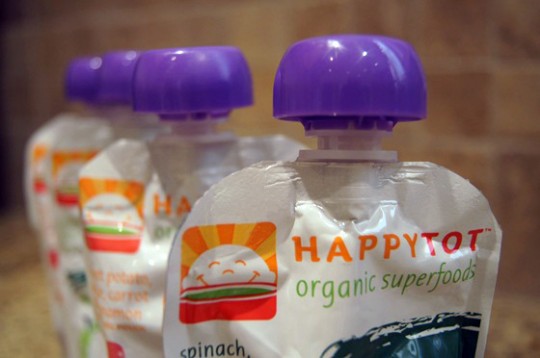To squeeze or not to squeeze: Using packaged foods to increase a child’s fruit and veggie intake
To squeeze or not to squeeze: Using packaged foods to increase a child’s fruit and veggie intake

I feel guilty. That’s what I told a good girlfriend as we strolled through the San Francisco streets for our weekly walk last night. My mom-guilt didn’t involve (this time) not spending enough time with my two young daughters or losing my temper with one of them. Instead, it had to do with “squeezers” – those little portable packages of pureed fruit and vegetables – and the fact that I so often give them to my girls. These beloved children’s snack items are not at all good for the environment (hence, the guilt) – but they have other things going for them. Namely, they’re organic and natural, and the girls love them.
Imagine my interest, then, when I came across this piece from The Atlantic (headline: “The Trouble With Fruit You Can Squeeze and Eat”) this morning. In it, writer Helene York expresses her concerns with these packaged food items, which she considers part of a “disturbing trend:”
From a nutritional standpoint, an apple beats tube food in every category: half the calories, more vitamins, only 20 percent of the sugars (think diabetes) ounce for ounce. But the increased sugars no doubt heighten a child’s delight, and makes a real apple, pear, or a bunch of grapes less appealing by comparison. What’s more, an apple doesn’t come in multi-colored disposable packaging. What’s happened to our eating habits when we have to manipulate children into eating fruit? I thought we rejected Space Food decades ago.
York goes on to make some other thought-provoking points, writing, for example, that “our acceptance of ‘all-natural’ snacks and beverages may be subtly disconnecting us and our kids from real food.” She’s on to something here, and in an ideal world my daughterswould eat a pear, versus a green-bean-pear-and-pea squeezer. But there’s the thing: While my youngest daughter would (and does) happily gobble up a pear (or peach or kiwi), my 5-year-old refuses to eat fruits and vegetables unless they’re: (a) with yogurt in a smoothie; or (b) in a squeezer. I’ll continue offering her the “real thing,” but until she grows out of this phase, I need to make sure she gets the necessary vitamins and goodies that come from fruits and veggies in some form. So smoothie or squeezer it is!
York closes by rhetorically asking, “because if all of the ingredients are fruit in some form, the contents are organic, and if it’s fun to eat fruit out of a squeezable tube, then what’s wrong with that?” And I have to answer: I don’t think there is much wrong with that.
By Michelle Brandt
Stanford University Medical Center
###
* Stanford University Medical Center integrates research, medical education and patient care at its three institutions – Stanford University School of Medicine, Stanford Hospital & Clinics and Lucile Packard Children’s Hospital.
** The above story is adapted from materials provided by Stanford University School of Medicine
________________________________________________________________


















